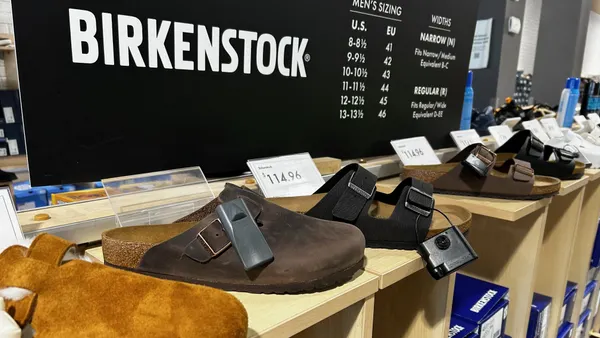Dive Brief:
-
Target's traffic and sales improved “meaningfully” in the third quarter, thanks to an "unexpectedly" strong back-to-school season, CEO Brian Cornell said in a press release Wednesday.
-
Target's Q3 sales decreased 6.7% to $16.4 billion, down from $17.6 billion last year, but same-store e-commerce sales grew 26%, contributing 0.7 percentage points to same-store sales growth. Same-store sales declined 0.2%, near the high-end of the guidance range of flat to down 2%.
-
In reflection of the positive quarter results, Target raised its estimates for adjusted earnings per share to $3.46 to $3.48, from its prior guidance of $3.39 to $3.43.
Dive Insight:
Target’s approach of using merchandise differentiation, which has allowed it to largely avoiding major price wars with the likes of dollar stores and Wal-Mart, appears to be paying off. Same-store sales growth in Target's “Signature Categories,” including baby and wellness, outpaced total comparable sales by more than 3 percentage points.
The report bodes well for the holiday quarter as well, according to Moody’s lead retail analyst Charlie O’Shea, who said Target's growth in online sales helps place the retailer “near the top of the brick-and-mortar retail universe.”
Target's “gross margin for the quarter, excluding the impact of the sold pharmacy business, was up around 25 basis points, which we believe is impressive given the high level of promotional activity we noticed in key back-to-college and back-to-school categories,” O’Shea said in a note emailed to Retail Dive. “This seems to indicate that, among other things, the new product launches, in particular Cat & Jack and Pillowfort, are likely resonating with consumers. All in all, Target seems well-positioned for a successful holiday season and Q4.”
The retailer’s third quarter performance ends what Conlumino retail analyst Neil Saunders called a “relatively gloomy first half” of the year. In a note emailed to Retail Dive, Saunders said Target’s differentiated product offerings are resonating with customers and helping it excel during seasonal periods like back-to-school and the upcoming holidays.
“[S]easonal events are an example of where Target excels: it has a comprehensive, yet not overwhelming, range of products at competitive prices, which it merchandises in dedicated areas to great effect,” Saunders said.
But that also reflects one of Target’s weaknesses — sustaining appeal during off-season times. That’s evident when you look deeper into the company’s same-store sales, which show that transaction numbers and units per transaction are down. Conlumino’s data show existing customers have cut visit frequency to Target, even if only slightly.
“Although Target’s performance has improved, it would be wrong to say that it is a now company firing on all cylinders. Underlying sales growth remains very soft and underscores the fact that, overall, Target is losing market share. This is especially so for physical shops where same store sales declined by 1% during the quarter; by comparison digital sales increased by 0.7% on a comparable basis,” Saunders said. “This dynamic highlights one of the core issues with Target: while it is good at drawing consumers in for specific purposes and occasions, it is much less effective at building everyday traffic and sales.”
In Saunders’ view, Target must “rip up the grocery rule book,” and improve its stores’ and its departments’ appeal in order to make its merchandise and stores more inspiring and entice shoppers to come in more often and spend in new categories. While Saunders said these weaknesses are holding Target back, he also said the retailer is moving in the right direction.
“It is also in a far better position than many of its mass merchant rivals, with a stronger underlying financial and sales position," he said. "Interestingly, it is also highly regarded by shoppers: from our survey data many people like Target and think well of the brand. These are solid foundations and they are, in our view, foundations on which Target should build more ambitiously and expeditiously than it is currently doing.”














